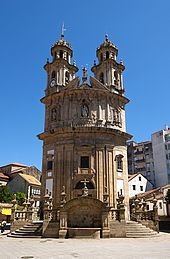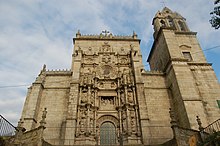Pontevedra
| Pontevedra | ||
|---|---|---|
 San Francisco Church
|
||
| coat of arms | Map of Spain | |

|
|
|
| Basic data | ||
| Autonomous Community : |
|
|
| Province : | Pontevedra | |
| Coordinates | 42 ° 26 ′ N , 8 ° 39 ′ W | |
| Height : | 20 msnm | |
| Area : | 117 km² | |
| Residents : | 83,029 (Jan. 1, 2019) | |
| Population density : | 709.65 inhabitants / km² | |
| Postal code : | 36000 | |
| Municipality number ( INE ): | 36038 | |
| administration | ||
| Official language : | Castilian , Galician | |
| Mayor : | Miguel Anxo Fernández Lores ( BNG ) | |
| Website : | www.pontevedra.eu www.visit-pontevedra.com | |
| Location of the city | ||

|
||
Pontevedra is a city in northwestern Spain . It belongs to the province of the same name Pontevedra , which is located within the autonomous region of Galicia . The city is also located on the Ría de Pontevedra and the Atlantic Ocean .
Pontevedra has 83,029 inhabitants (as of January 1, 2019) and is the provincial capital. The Morraza Peninsula is offshore, south-west.
Geographical description
Pontevedra is divided into 18 parroquias . The city lies deep in a ria , the Ría de Pontevedra , at the mouth of the Lérez River . The sandbanks in front of it protect the city from the rigors of the sea, which shaped both the city itself and its residents.
Pontevedra is in the center of the Rías Baixas . Only a few kilometers away is the Castiñeiras lake, the Couto Redondo viewpoint, the beaches of the Morrazo and Sanxenxo peninsulas, the fishing village of Combarro or the Illas Cíes and the island of A Toxa.
There are four mountain zones in the district. They are formed by two geographical folds that converge towards the capital. The first is a depression that stretches from Carballo to Tui and forms the traffic axis of Western Galicia. The second depression forms the river bed for the Lérez.
This municipality extends at the deepest, inland point of the estuary, which it also bears its name. It occupies the Lérez and Tomeza river valleys and borders in the south, in Ponte Sampaio, with the mouth of the Verdugo river.
The water-rich Lérez River is the most important river in the region. The tides of the sea also affect its mouth, which was the reason for the creation of the port around which the city later developed.
During the whole year it rains only moderately with pleasant temperatures.
history
The Legend of Pontevedra was Teukros , a Greek hero of the Trojan War , v to the 1200th Founded. In contrast, the presence of the Romans is historically documented , so that it can be assumed that the city emerged from a Roman settlement. The Romans called the settlement Ad Duos Pontes (To the Two Bridges) and later Pontis Veteris (Old Bridge), from which Pontevedra developed.
Proof that Pontevedra has been inhabited since the early Paleolithic are the axes found on the terraces of the river banks. There was also a culture of castros (fortified structures), as evidenced by the remains found at the Mouronte and Salcedo archaeological sites. Bronze fish hooks and stones that were used for fishing were also found there.
The landmark of Pontevedra, which is deeply rooted in the city, is the Roman bridge attributed to the Greek builder Teukros. He is said to have traveled west after the Trojan War to found the small town. However, it was the Romans who built the predecessor of today's Burgo bridge over the Lérez and founded the Roman Vila Turoqua on Roman road XIX.
In the 12th century, under the reign of Fernando II , the city is mentioned for the first time under its current name - Pontem Vetris - in a document from the Poio Monastery. This name refers to the old Roman bridge . Over time, more bridges were built over the Lérez. The creation of these transport connections was one of the prerequisites for the growth and expansion of the city.
During the 14th century, new privileges strengthened the suburb of Pontevedras. These mainly concerned port activities and fishing . Sardine fishing is the most important economic pillar: catching it, selling fresh fish inland, curing, smoking and exporting it by sea. This made Pontevedra the most important port in Galicia.
Pontevedra experienced its greatest economic and social boom during the 16th century, above all because of its strategic location for the Atlantic routes and because of its social peace. In stark contrast is the city's crisis during the 17th, 18th and 19th centuries. During this time, the port lost its importance, climatic catastrophes struck Galicia during this period, and the bourgeoisie preferred to invest their capital in safer investments. After two centuries of decadence and crisis, Pontevedra has been experiencing a new phase of economic and demographic growth since the mid-19th century.
In 1999 Pontevedra banned motor vehicles from its historic center and created a 300,000 m² pedestrian zone . The car-free inner city transformed Pontevedra into a barrier-free city, whose quality of life was recognized with the "Intermodes" Prize 2013, the Habitat Prize 2014 and the "Excellence Prize" of the Center for Active Design in New York City 2015.
Demographic development
| 1857 | 1877 | 1887 | 1900 | 1910 | 1920 | 1930 | 1940 | 1950 | 1960 | 1970 | 1981 | 1991 | 2001 | 2010 | 2013 |
|---|---|---|---|---|---|---|---|---|---|---|---|---|---|---|---|
| 6,623 | 20,140 | 20,550 | 22.806 | 25,072 | 28,957 | 30,821 | 36,968 | 43,221 | 50,575 | 52,562 | 65,137 | 75,148 | 74,942 | 81,981 | 82,934 |
Attractions
The center of Pontevedra is the Plaza Ferrería, surrounded by three squares. The name comes from the iron smiths who long ago went about their work under the colonnades. Together with the famous Ferrería Fountain and the San Francisco Convent, they form a characteristic complex of the city. The Basilica of Santa Maria with its Plateresco principal façade illustrates the power of the fishing community and the Merchant Shipping Association (Gremio de Mareantes), which focused particularly in the suburbs Moureira.
Pontevedra, the capital of the Portuguese Way of St. James, was a mandatory stage destination for millions of pilgrims who refreshed themselves at the Ferrería fountain. The Virxe Peregrina (virgin pilgrim) symbolizes the close connection between the city and the cult of St. James. The church of the patron saint of this city is an original construction from the late 18th century. Her style is a symbiosis of baroque and classicism with a Portuguese influence. It has a round floor plan resembling a scallop shell .
The provincial museum, which comprises five buildings, houses a valuable collection of Celtic goldsmiths' work and utensils from the Neolithic, as well as a collection of paintings and amber.
The sacred buildings include the Church of San Bartolomeo, the Monastery of Santa Clara, the Monastery of San Francisco and the ruins of the Church of San Domingos. On the outskirts of the city is the Benedictine monastery of Lérez, whose cloister from the 16th century is partially preserved. Its neoclassical church with the baroque facade dates from the 18th century.
The pazos (noble houses) as evidence of courtly architecture include the Casa del Barón (formerly Pazo de Maceda), now a Parador National, as well as Gandarón and Miradores in Salcedo, the Pazo Lourizán, the Pazo Pedreira in Campañó and the manor house Santa Maria in Xeve.
The Illa das Esculturas de Pontevedra is a sculpture park.
Free time activities
Pontevedra offers a variety of options for an active holiday, e.g. B. Walks on the Camino de Santiago or on paths between the Rías, starting from the Sampaio bridge to the city. Canoeists, rowers and cyclists will find excellent conditions here to pursue their sport.
Celebrations and events
Pontevedra is a city with deeply rooted traditions. His special festivities include that of the Maios, a festival at the beginning of spring, and the funeral of Loro Ravachol (parrot), a spectacle at the end of the Carnival that honors the popular mascot who visits his master, Don Perfecto Feijoo announced his pharmacy. On this day and on this occasion, many residents of Pontevedra gather there with their pets.
The feast in honor of the pilgrim in August is celebrated, among other things, with bullfights in the only arena in Galicia. The city continues to host cultural events such as the International Art Biennale. In addition to theater performances, the Teatro Principal also hosts classical concerts organized by the Philharmonic Society.
The parishes also celebrate their folk festivals. The following are particularly worth mentioning:
- On March 8th there is the Caldo festival (typical Galician stew) in Mourente.
- July 11th is the day of San Bieitiño de Lérez.
- On September 29th and 30th and October 1st, Marcón celebrates St. Michael's Day.
- November 11th is the festival in honor of San Martiño in Salcedo.
- On November 30th, in Xeve and Lourizán, there is a festival in honor of St. Andrew.
Market day in Pontevedra is on the 1st, 8th, 15th and 23rd of each month. In October the building fair, the tourism fair and the Expovoda take place. The livestock market and an exhibition and sale of agricultural machinery and products is held on the 1st and 15th of each month.
sons and daughters of the town
- Jorge Castillo (* 1933), artist
- Diego Castro (* 1982), football player
- David García (* 1977), racing cyclist
- Lourdes Domínguez Lino (born 1981), tennis player
- Celso Míguez (* 1983), racing car driver
- Francisco Millán Mon (* 1955), politician and diplomat
- Óscar Pereiro (* 1977), racing cyclist
- Marcos Serrano (* 1972), racing cyclist
- Manuel Quiroga Losada (1892–1961), violinist
Web links
- Concello de Pontevedra - Official website of the City of Pontevedra (Spanish)
- Information about Pontevedra (Galician, Spanish, English, French)
Individual evidence
- ↑ Cifras oficiales de población resultantes de la revisión del Padrón municipal a 1 de enero . Population statistics from the Instituto Nacional de Estadística (population update).
- ↑ 'For me, this is paradise': life in the Spanish city that banned cars.
- ^ Center for Active Design, New York .
| ← Previous location: Redondela 20 km |
|
Next town: Caldas de Reis 25 km → |











